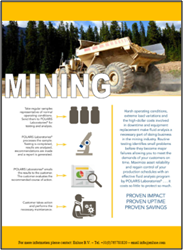Oil and Gas
Downtime is the oil and gas industry’s number one enemy. In an environment where equipment is expected to run 24 hours a day, 7 days a week under extreme conditions, downtime caused by equipment failure can quickly put a company out of business. Oil analysis can predict equipment failure before it happens and eliminate downtime – saving you time and money.
- Predict Equipment Failure
- Eliminate Downtime
- Increase Asset Reliability
- Reduce Costs
Oil Analysis cannot only detect equipment failures in progress but point you straight to the root cause of a problem as well, enabling you to prevent catastrophic failures and costly losses in production. No matter what the application – on or off-shore drilling, field services or oil & gas production – if equipment is down, it’s costing you money. Highly contaminated operating environments, extreme operating conditions and the economics of equipment replacement only increase the value of oil analysis as a necessary part of managing asset reliability.
Coolant Analysis
Coolant Analysis takes the guess work out of properly maintaining a cooling system and can identify maintenance problems before catastrophic engine failure occurs. Regular coolant testing and routine maintenance can help you achieve maximum system efficiency and save you time and money in less downtime, fewer repairs and determining proper drain intervals.
Engines
Diesel and natural gas engine oils should be tested routinely for contamination and wear.
Compressor Systems
Replacement units/parts may be difficult to obtain – valuable time and money are lost in downtime.
Hydraulic Systems
Biggest concern is water contamination, which accelerates acid formation, increases oxidation and reduces lubricity – all leading to system failure.
Gear Systems
Direct Read Ferrography provides a ratio of large to small ferrous particles. DR reports a quantitative value that indicates amount of ferrous wear occurring – provides tremendously helpful trending information.
Turbines
Turbine reliability is always critical and oil changes or failures are always expensive. Routine trend analysis is crucial to predictive turbine maintenance.














